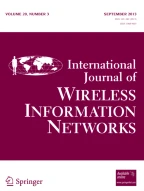Abstract
New technology is needed to meet the ever growing demand for wireless services. The cellular packet switch (CPS) has been proposed as a distributed switching architecture capable of handling the increasing needs of high-density personal communication systems. The IEEE 802.6 metropolitan area network (MAN) is a possible candidate for the backbone of the CPS. This paper calculates the capacity of the CPS. Given an available bandwidth, an exact expression for the number of cells supported by an IEEE 802.6 MAN is derived as a function of the protocols and rates of occurrence of call setups, handovers, and registrations. To provide insight into the effect of each user, a model of mobility, shown previously to be realistic for a regular grid of streets (a “Manhattan grid”), provides an accurate estimate of the frequency of handovers and registrations. Numerical examples based on CCIR estimates of traffic show how MAN bandwidth gets divided between user and signaling information and how well the signaling message load is distributed between the various processors that make up the CPS.
Similar content being viewed by others
References
E. Alonso, K. S. Meier-Hellstern, and G. P. Pollini, Influence of cell geometry on handover and registration rates in cellular and universal personal telecommunications networks,8th International Teletraffic Seminar, Santa Margherita Ligure (Genova), Italy, pp. 261–270, 1992.
CCIR Report M/8 (mod.F),Future Public Land Mobile Telecommunication Systems, Document 8/1014-E, 1989.
M. Conti, E. Gregori, and L. Lanzini, A methodological approach to an extensive analysis of DQDB performance and fairness,IEEE Journal of Selected Areas in Communications, Vol. 9, No. 1, pp. 76–87, 1991.
D. J. Goodman, Cellular packet communications,IEEE Transactions on Communications, Vol. 37, No. 8, pp. 885–890, 1989.
D. J. Goodman, K. T. Valenzuela, K. T. Gayliard, and B. Rammamurthi, Packet reservation multiple access for local wireless communications,IEEE Trans. Comm., Vol. 37, No. 8, pp. 885–890, 1989.
S. Hatamian, Enhanced speech activity detection for mobile telephony, Masters Thesis, Rutgers, The State University of New Jersey, 1991.
IEEE 802.6: Distributed Queue Dual Bus (DQDB) Subnetwork of a Metropolitan Area Network (MAN), P802.6/D15, 1990.
A. D. Malyan, L. J. Ng, and V. C. M. Leung, Network architecture and signaling for wireless personal communications,IEEE Journal of Selected Areas in Communications, Vol. 11, No. 6, p. 830, 1993.
Adolph D. May,Traffic Flow Fundamentals, Prentice Hall, Englewood Cliffs, NJ, May 1990.
K. L. Meier-Hellstern E. Alonso, D. O'Neil, The use of SS7 and GSM to support high density personal communications,Proceedings of ICC 92, Chicago, IL. Paper 356.2, 1992.
K. S. Meier-Hellstern, G. P. Pollini, D. J. Goodman, A wireless service for the IEEE 802.6 metropolitan area network,Proceedings of Globecom 91, Phoenix, AZ, pp. 1964–1968, 1991.
K. S. Meier-Hellstern, G. P. Pollini, D. J. Goodman, Network protocols for the cellular packet switch,Proceedings of the IEEE Vehicular Technology Conference, Denver, CO, pp. 705–710, 1992. To appear inIEEE Transaction on Communications.
H. Minhas, GSM signaling on the radio path: a dimensioning study,Proceedings of the International Conference on Digital Land Mobile Radio Communications, Venice, Italy, 1987.
G. P. Pollini, Capacity of the cellular packet switch, Masters Thesis, Rutgers, The State University of New Jersey, 1992; see alsoProceedings of ICC 93, Geneva, Switzerland, pp. 1264–1268, 1993.
I. Seskar, S. Marić, J. Holtzman, J. Wasserman, Rate of location area updates in cellular systems,Proceedings VTC 92, Denver, CO, pp. 694–697, 1992.
R. Thomas, H. Gilbert, G. Mazziotto, Influence of the moving of the mobile stations on the performance of a radio mobile cellular network,Proceedings of the 3rd Nordic Seminar, Paper 9.4, Copenhagen, Denmark, 1988.
Author information
Authors and Affiliations
Rights and permissions
About this article
Cite this article
Pollini, G.P. Capacity of the cellular packet switch. Int J Wireless Inf Networks 1, 289–298 (1994). https://doi.org/10.1007/BF02106594
Issue Date:
DOI: https://doi.org/10.1007/BF02106594
